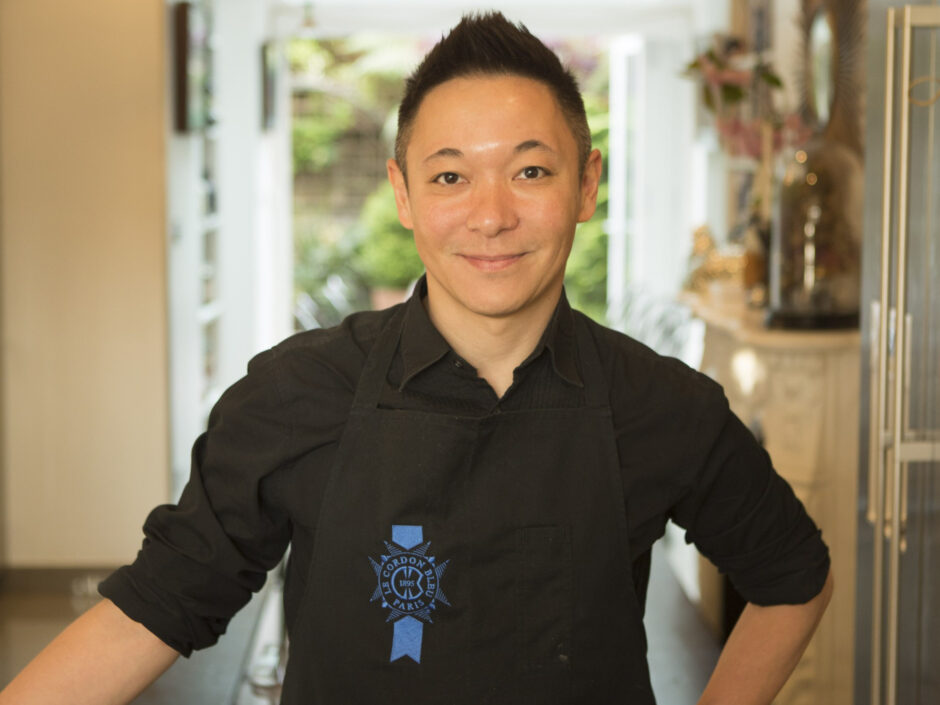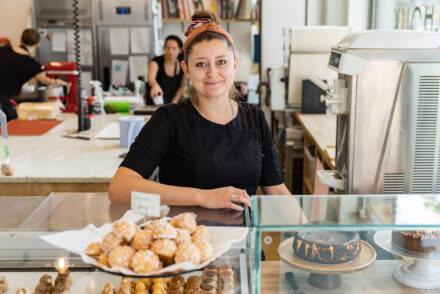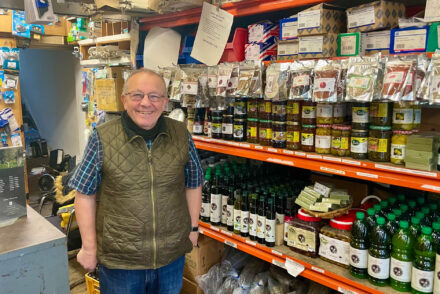Luiz Hara is an ex-banker turned Le Cordon Bleu chef, cookbook author and food writer. He founded The London Foodie blog in 2009 and hosts Nikkei supper clubs in his gorgeous Islington home.
Palate contributing writer Amanda David (AD) caught up with Luiz Hara (LH) to discuss the origins of Nikkei cuisine, developing a love of food and how to start a supper club.
AD: Luiz, how would you define Nikkei cuisine?
LH: Nikkei cuisine originated when Japanese immigrants moved to South America. They wanted to eat familiar Japanese food but they didn’t have the ingredients, so they had to create their own style of food using the local produce. In Brazil, they used to eat a lot of pork and pork fat. Japanese people at that time didn’t eat a lot of meat, so even using pork fat to fry vegetables was very new to them. But necessity is the mother of invention; if you need to feed a family, you find a way.
AD: I’m struggling to think of many cuisines that are quite so dissimilar!
LH: Brazilians love their meat. Traditionally, to make ‘Feijoada’ (our national dish), we use many different cuts of pork. Some of these are very gelatinous – the ears, snout and tail – with a lot of collagen, which thickens the dish and gives it flavour. But the influence worked the other way round too. Ceviche originated in or around Peru thousands of years ago but it wasn’t ceviche as we know it now; they used to leave the fish in the lime juice overnight until the texture was very firm. Then the Japanese, who were used to the delicate texture and flavour of raw fish, starting making ceviche and serving it only very lightly marinated; and that’s the origin of modern ceviche.
AD: What caused the influx of Japanese immigrants?
LH: Two things happened concurrently. First, the Meiji Restoration at the end of the nineteenth century. Japan was closed to the outside world for nearly three hundred years then Meiji came in as emperor and made Japan more open and modern. At the same time, Brazil became the last country in the Americas to abolish slavery in 1888 and desperately needed people to come and work the land, as they had a huge coffee trade.
Brazil entered into an agreement with Japan in 1908, where Brazil paid for the workers’ travel and Japan encouraged their citizens to go. There was a huge push for modernisation in Japan at the time; many of the farmers in the countryside couldn’t keep up and were starving. They were promised a land of opportunity but when they got there the conditions were terrible and they had to work just to repay their travel costs.
AD: That sounds depressingly familiar.
LH: Absolutely. My grandparents were basically economic migrants. They were sent with the other Japanese workers from the port of Santos by train to a huge hostel for immigrants in São Paolo, kept there for a week or two, and made to sign a contract to work on one of the huge farms. They were then sent to coffee plantations spread across the countryside of Brazil, treated practically like slaves and of course had no idea how to plant coffee as they’d never seen it before.
Unable to farm, many of the Japanese went back to São Paolo and set up a whole range of businesses. Some of them stayed on the farms and introduced new techniques and new crops from the roots and seeds they had brought over with them; Sharon fruit or persimmon – in Japanese and Portuguese it’s called kaki – was brought to Brazil during this period.
AD: When did you first become interested in cooking?
LH: My family migrated to Brazil from Japan; I lived with my father and grandmother in a Japanese house in the middle of São Paolo. It was quite odd! I remember going to the weekly fish market and the fruit and veg market with my grandmother when I was about nine years old, helping her communicate as she couldn’t speak Portuguese very well. So I grew up helping her to choose and buy the ingredients, watching her cook those ingredients and then how she plated the dishes; that was a real lesson for me. She was very thrifty – she had to be, she was feeding an extended family.
Then, as an adult, I was very lucky in the sense that I love eating. I would go to a lot of restaurants and just soak up all this information – notice a new way of serving something, or an unusual flavour combination. I was classically trained as a chef at Le Cordon Bleu London where I graduated with the Grande Diplome, but I think about half of my learning has been just going out to really good restaurants and trying the food. Also travelling, seeing what people are doing, getting inspired, trying different ingredients; having that mentality of always wanting to learn more.
Running supper clubs is a lot of work but a lot of fun too!
AD: If I wanted to cook Nikkei dishes at home, where should I start?
LH: Always with Japanese cooking, the base of everything you do is a good dashi that you can use for different dishes. I love one-pot rice dishes; one of my favourites is this chicken rice, cooked in beer and coriander and dashi, called Arroz con Pollo (rice with chicken). It’s very home-style, but one of my favourite Nikkei dishes.
If you want to learn more about Peruvian flavours, I recommend going to a Latin American store (or online) and buying three different ajis, or chilli pastes. Start with aji amarillo, the yellow chilli paste, which has a fruity flavour and makes a delicious base for a range of sauces. I love using it with salmon, in a leche de tigre with ginger, passion fruit and sake. It’s also fabulous with chicken kaarage; add it to a dressing of Kewpie mayo, a little Greek yoghurt and lemon instead of wasabi. Aji rocoto is the red one, and then there’s aji panca, which is milder and has a smoky flavour that works really well with beef. With Peruvian chillies, it’s not just about heat; they each have a distinctive flavour and are an integral part of the cuisine.
AD: I was introduced to Nikkei cuisine at one of your fabulous supper clubs, many years ago. How did they start?
LH: At the time I had my blog The London Foodie , which I started in 2009. It’s very neglected now, but I used to write a lot for it and it was quite popular. I had about 20,000 followers and I put the word out about my first supper club, and that’s how it came about.
AD: What advice would you have for someone thinking of starting a supper club?
LH: Just go for it. I have volunteers now who want to start a supper club and so they come to help me. My advice is not to think too much about the money at first. Have a budget, and don’t make a loss, but at the start it should all be about being a generous host and people having a wonderful time. This is the moment to create something, get your name out there and have people say, ‘Wow that was an amazing evening, I’ll come back.’
We’ve met so many lovely people over the years, and you only learn when you are outside of your comfort zone. I’ve learned so much about breaking down recipes into things that can be done in advance; that’s not the kind of thing I learned at culinary school. You only really learn how to cook for large numbers of people, how to manage a kitchen and how to budget, if you actually do it. Running a supper club gives you that experience. A lot of people start with supper clubs before opening their own restaurants.
AD: Asma Khan, famously.
LH: Yes, and Nuno Mendes. I went to his supper club in his home on Kingsland Road over ten years ago now. It was very expensive and he had lots of people helping him but the food was incredible, and he served some spectacular wines which were all included. He was doing the whole molecular gastronomy thing, spherification and so on, which was very of the moment; then he would take you to the kitchen and show you how he did it.
AD: You have a guide to supper club etiquette on your website, which I think is such a good idea. Has it ever been difficult, hosting dinner in your own house?
LH: It’s a unique set up. You do sometimes have to remind people that it’s your house; it’s not Come Dine With Me, you can’t wander into my bedroom and look through my wardrobe! I cannot complain, people are very polite and respectful most of the time; I’ve only had a couple of difficult people over the 12 years.
Recently it’s been tough to get the staff and despite all the hard work and long hours, I do enjoy it very much. I love being creative when designing the menu, doing all the shopping and prep, spending days cooking then hosting 32 hungry but happy diners who will be knocking on my door at 18:30 sharp come what may. I have met the most incredible people over the years at my supper club, many of whom are now close friends. I would wholeheartedly recommend it; running supper clubs is a lot of work but a lot of fun too!
You can follow Luiz Hara on his Instagram and Thread accounts @thelondonfoodie.
Photo courtesy of Luiz Hara.
September 2023






